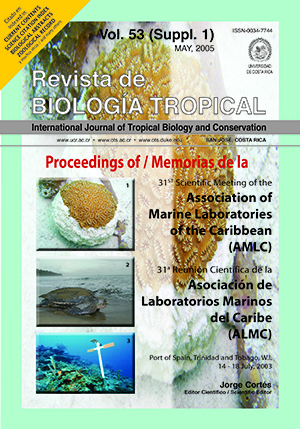Abstract
One of the current problems in the field of coral disease research is that of tracking coral pathogens in the natural environment. A promising method to do this is by use of pathogen-specific molecular probes. However, this approach has been little used to date. We constructed, and validated in the laboratory, a fluorochrome- labeled molecular probe specific to Aurantimonas coralicida, the bacterial pathogen of the Caribbean coral disease white plague type II (WPII). We then used the probe to test field samples of diseased coral tissue for the presence of this pathogen. Probe design was based on a unique subset (25 nucleotides) of the complete16S rRNA gene sequence derived from a pure culture of the pathogen. The pathogen-specific probe was labeled with the fluorochrome GreenStar*™ FITC (fluorescein isothiocyanate, GeneDetect Ltd, New Zealand). As a control, we used the universal eubacterial probe EUB 338, labeled with a different fluorochrome (TRITC, tetra-methylrhodamine isothiocyanate). Both probes were applied to laboratory samples of pure cultures of bacteria, and field samples collected from the surface of the disease line of corals exhibiting signs of white plague (types I and II), healthy controls, and corals with an uncharacterized disease (“patchy necrosis”). All samples were analyzed using fluorescence in situ hybridization (FISH). We have determined that the probe is specific to our laboratory culture of the coral pathogen, and does not react with other bacterial species (the eubacterial probe does). The WPII pathogen was detected in association with diseased coral samples collected from coral colonies on reefs of the Bahamas (n= 9 samples) exhibiting signs of both WPI and WPII. Diseased (and healthy) tissue samples (n= 4) from corals exhibiting signs of “patchy necrosis” were also assayed. In this case the results were negative, indicating that the same pathogen is not involved in the two diseases. Incorporation and use of pathogen-specific probes can significantly expand our knowledge of the etiology of coral diseasesReferences
Amann, R.I. 1995. In situ identification of micro-organisms by whole cell hybridization with rRNA-targeted nucleic acid probes, p. 1-15. In A.D.L. Akkerman, J.D. van Elsas & F.J. de Bruijn (eds.). Molecular Microbial Ecology Manual. Kluwer Academic Publishers, Dordrecht, The Netherlands.
Antonius, A. 1973. New observations on coral destruction in reefs. 10th Mtg. Assoc. Isl. Mar. Lab. Carib. 10: 3.
Borger, J. 2003. Three scleractinian coral diseases in Dominica, West Indies: Distribution, infection patterns, and contribution to coral tissue mortality. Rev. Biol. Trop. 5 (Supl. 4): 25-38.
Bythell, J., M. Barer, R. Cooney, J. Guest, A. O’Donnell, O. Pantos & M. Le Tissier. 2002. Histopathological methods for the investigation of microbial communities associated with disease lesions in reef corals. Lett. Appl. Microbiol. 34: 111-116.
Bythell, J., O. Pantos & L. Richardson. 2004. White plague, white band, and other “white” diseases, p. 351-365. In E. Rosenberg &Y. Loya (eds.). Coral Health and Disease. Springer-Verlag, Berlin.
Croquer, A., S.M. Pauls & A.L. Zubillaga. 2003. White plague disease outbreak in a coral reef at Los Roques National Park, Venezuela. Rev. Biol. Trop. 5 (Supl. 4): 39-45.
Denner, E.B.M., G.W. Smith, H-J Busse, P. Schumann, T. Narzt, S. Polson, W. Lubitz & L.L. Richardson. 2003. Aurantimonas coralicida gen. nov., sp. nov., the causative agent of white plague type II on Caribbean scleractinian corals. Intl. J. Syst. Evol. Microbiol. 53: 1115-1122.
Dustan, P. 1977. Vitality of reef coral populations off Key Largo, Florida: Recruitment and mortality. Env. Geol. 2: 51-58.
Dustan, P. & J. Halas. 1987. Changes in the reef-coral community of Carysfort Reef, Key Largo, Florida: 1974-1982. Coral Reefs 6: 91-106.
Gladfelter, W.B., E.H. Gladfelter, R.K. Monahan, J.C.Ogden, & R.F. Dill. 1977. Environmental studies of Buck Island Reef National Monument, St. Croix US Virgin Islands. Spec. Rep. Nat. Park Serv. US Dept Int. 173 p.
Green, E.P. & A.W. Bruckner. 2000. The significance of coral disease epizootiology for coral reef conservation. Biol. Cons. 96: 347-361.
Harvell, C.D., K. Kim, J.M. Burkholder, R.R. Colwell, P.R. Epstein, D.J. Grimes, E.E. Hofmann, E.K. Lipp, A.D.M.E. Osterhaus, R.M. Overstreet, J.W. Porter, G.W. Smith & G.R. Vasta. 1999. Emerging marine diseases - climate links and anthropogenic factors. Science 285: 1505-1510.
Miller, J., C. Rogers & R. Waara. 2003. Monitoring the coral disease, white plague type II, on coral reefs in St. John, U.S. Virgin Islands. Rev. Biol. Trop. 5 (Supl. 4): 47-55.
Pantos, O., R. Cooney, M. Le Tissier, M. Barer, A. O’Donnell & J. Bythell. 2003. The bacterial ecology of a plague-like disease affecting the Caribbean coral Montastraea annularis. Env. Microbiol. 5: 370-382.
Richardson, L.L., W.M. Goldberg, R.G. Carlton & J.C. Halas. 1998a. Coral disease outbreak in the Florida Keys: Plague type II. Rev. Biol. Trop. 46 (Supl. 5): 187-198.
Richardson, L.L., W.M. Goldberg, K.G. Kuta, R.B. Aronson, G.W. Smith, K.B. Ritchie, J.C. Halas, J.S. Feingold & S.L. Miller. 1998b. Florida’s mystery coral killer explained. Nature 392: 557-558.
Richardson, L.L., G.W. Smith, K.B. Ritchie & R.G. Carlton. 2001. Integrating microbiological, microsensor, physiologic and molecular techniques in the study of coral disease pathogenesis. Hydrobiol. 460: 71-89.
Ritchie, K.B., S.W. Polson & G.W. Smith. 2001. Microbial disease causation in marine invertebrates: Problems, practices, and future prospects. Hydrobiol. 460: 131-139.
Rodriguez-Martinez, R.E., A.T. Banaszak & E. Jordan- Dahlgren. 2001. Necrotic patches affect Acropora palmata (Scleractinia: acroporidae) in the Mexican Caribbean. Dis. Aquat. Org. 47: 229-234.
Rosenberg, E. & Y. Loya. 2004. Coral Health and Disease. Springer-Verlag, Berlin. 488 p.
Sutherland, K.P., J.W. Porter & C. Torres. 2004. Disease and immunity in Caribbean and Indo-Pacific zooxanthellate corals. Mar. Ecol. Prog. Ser. 266: 273-302.
Weil, E. 2004. Coral reef diseases in the wider Caribbean, p. 35-68. In E. Rosenberg & Y. Loya (eds.). Coral Health and Disease. Springer-Verlag, Berlin.
Weil, E., I. Urreiztieta & J. Garzon-Ferreira. 2002. Geographic variability in the incidence of coral and octocoral diseases in the wider Caribbean. Proc. 9th Int. Coral Reef Symp. 2: 1231-1238.
##plugins.facebook.comentarios##

This work is licensed under a Creative Commons Attribution 4.0 International License.
Copyright (c) 2005 Revista de Biología Tropical






